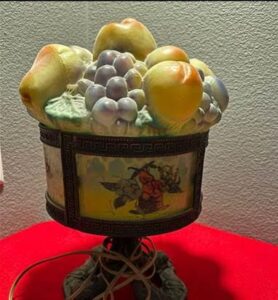 JP’s fruit bowl lamp at about twenty-four inches tall looks like a strange combination for us to see today. It’s a bowl of fruit sculpture and a lamp; Why? This “period piece” speaks of its time, a time confused about what a LAMP actually COULD BE.
JP’s fruit bowl lamp at about twenty-four inches tall looks like a strange combination for us to see today. It’s a bowl of fruit sculpture and a lamp; Why? This “period piece” speaks of its time, a time confused about what a LAMP actually COULD BE.
The hand blown glass shade was molded to resemble fruit, and then overpainted. “Kind of” lamps and “sort of” sculptures became popular in the late 1920s through 1930s when the US decided HOW to use a lamp.
A home originally lit from the walls or the ceiling now incorporated NEW electricity. TABLE lamps often came with a dramatic-thematic to make people LOOK at that lamp.
Fanciful Fruit Bowl Lamps
Their popularity might surprise you. The traditional bowl of fruit often signified a house with ‘extra’ – think of the cornucopia, which indicates abundance.
Czech glassblowers made two kinds of fruit bowl lamps for the US market. One, like JP’s, where the shade is one piece of blown glass set across an armature of a “bow.” The other, much more intricate, and more valuable in the market today, of tiny beads of glass dangling on a mesh of wire to create a shade, over a wire mesh and glass marbles accentuated “bowl.” In today’s TASTE, we don’t like a representative image. The 1930s intermixed glamor and tradition. People loved to bring something unique and “referential” of both tradition and glamor home for a decorative accent. This is completely not commensurate with Midcentury Modern, but fits into the Hollywood Regency style.
Think of movies in the 1930s, where a blonde in a slinky gown rests on a satin bed in a bedroom of flowers. The fruit bowl lamp originated there, stylistically and philosophically speaking.
Bohemian Glass
The area once called Bohemia, now part of the Czech Republic, became a glass making center in the 1250s. Between the two world wars, the US discovered Czech glass, and brands like Moser Glass started to export.
Nobility in Europe always loved Bohemian glass, only second to jewels in those days. Galls collections were arbiters of prestige. Louis XV, Elizabeth of Russia, and Maria Theresa of Austria each acquired numerous Bohemian glass chandeliers made for their palaces.
If you visited Milan’s La Scala, Rome’s Teatro del Opera, Versailles, or St Petersburg’s Hermitage Museum, you stood under a Bohemian glass chandelier.
JP’s little lamp came from the plentiful minerals found in Bohemia and Silesia; namely, potash, chalk, limestone, and silica. Schools to train glass artists, a tradition in Bohemia, still exist today. Communist domination of the area allowed them to flourish, because glass artists didn’t say much about politics. In the mid-19th century glassmaking schools in Bohemia exported teachers and workers all over Europe.
Czech crystal is different from US crystal in that Czech crystal contains twenty-four percent lead, and the US crystal contains less than two percent lead. Lead softens the glass and creates a fine surface for cutting. It adds to the weight of the glass and light disperses through the crystal “brighter.” From the 18th and early 19th century, in a candlelit room, the crystal light fixture dispersed more light and refracted more off the pendant drops of the scones or the chandelier. These drops dispersed and “threw” light across a room as big as a ballroom.
Fruit Bowl Lamp Allegory on Abundance
Fruit bowls, usually seen with real fruit on the sideboard or as a centerpiece on the table, designed as a lamp replaced that fruit bowl.
Museums in the Czech Republic today maintain collections of Bohemian glass. Prof. Libensky, a Bohemian glass midcentury legend, who designed an entire glass environment in the 1960s for the Czech Embassy in Stockholm, including melted glass sculpture for the walls and a glass light wall. He also designed a set of barware famous today and sold only at the Prague Museum of Glass. The value of the fruit bowl lamp is $500.